User Account Control, or just UAC is a part of the Windows security system which prevents apps from making unwanted changes on your PC. By default, the UAC prompt doesn't appear for the built-in Administrator account since it runs with full administrative privileges. For extra security, you can enable the UAC confirmation for that account.
Advertisеment
Since Windows Vista, Microsoft added a new security feature called User Account Control (UAC). It tries to prevent malicious apps from doing potentially harmful things on your PC. When some software tries to change system-related parts of the Registry or the file system, Windows 10 shows an UAC confirmation dialog, where the user should confirm if he really wants to make those changes. Usually, the apps that require elevation are related to the management of Windows or your computer in general. A good example would be the Registry Editor app.
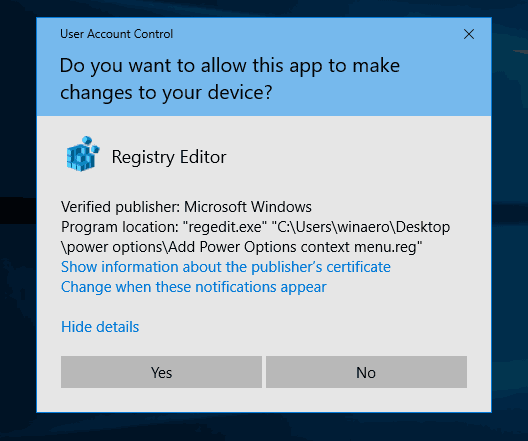
The UAC comes with different security levels. When its options are set to Always notify or Default, your Desktop will be dimmed. The session will be temporary switched to the secure Desktop without open windows and icons, containing only an elevation prompt by the User Account Control (UAC).
Members of the Administrators user group have to confirm or reject the UAC prompt without providing extra credentials (UAC consent prompt). Users without administrative privileges have to additionally enter valid credentials for a local administrator account (UAC credential prompt).
There is a special security policy in Windows 10 that determines the behavior of Admin Approval Mode for the built-in administrator account. When the Admin Approval Mode is enabled, the local administrator account functions like a standard user account, but it has the ability to elevate privileges without logging on by using a different account. In this mode, any operation that requires elevation of privilege displays a prompt that allows the administrator to permit or deny the elevation of privilege.
If you are running Windows 10 Pro, Enterprise, or Education edition, you can use the Local Security Policy app to enable the UAC prompt for the built-in Administrators. All editions of Windows 10 can use a Registry tweak mentioned below.
To Enable UAC Prompt for Built-in Administrator in Windows 10,
- Press Win + R keys together on your keyboard and type:
secpol.msc
Press Enter.
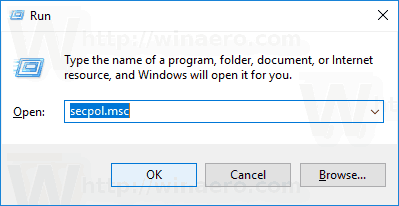
- Local Security Policy will open. Go to User Local Policies -> Security Options.
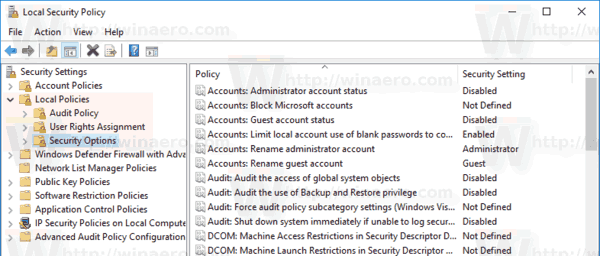
- On the right, scroll to the option User Account Control: Admin Approval Mode for the Built-in Administrator account.
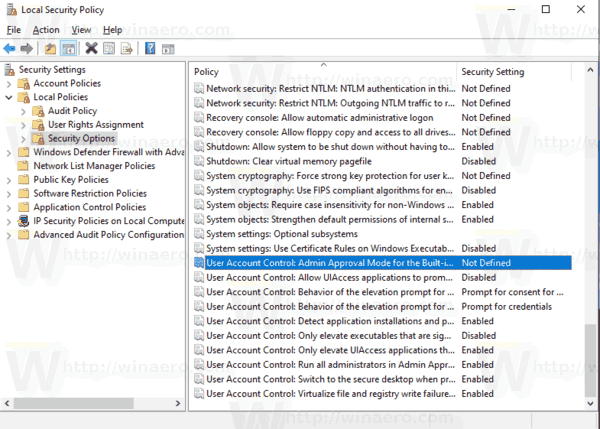
- Enable this policy to apply the change.
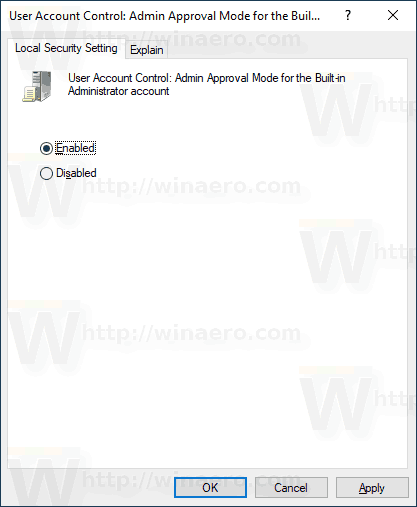
If your Windows edition doesn't include the secpol.msc tool, you can apply a Registry tweak as described below.
Enable UAC Prompt for Built-in Administrator with a Registry Tweak
- Open Registry Editor.
- Go to the following Registry key:
HKEY_LOCAL_MACHINE\SOFTWARE\Microsoft\Windows\CurrentVersion\Policies\System
Tip: See how to jump to the desired Registry key with one click.
If you do not have such a key, then just create it.
- Here, modify or create a new 32-bit DWORD value ValidateAdminCodeSignatures. Note: Even if you are running 64-bit Windows you must still create a 32-bit DWORD value. Set its value data to 1 to enable the feature.
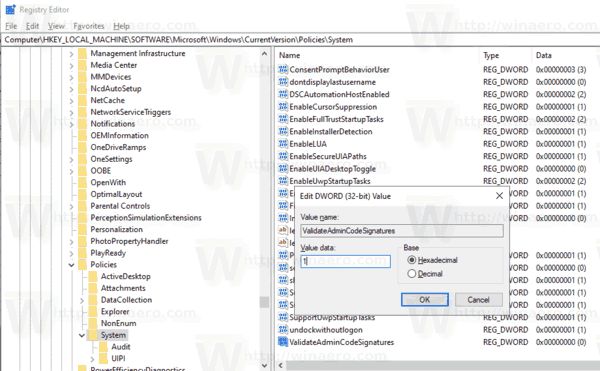
- A value data 0 will disable it. This is the default behavior.
- Restart Windows 10.
To save your time, you can download the following ready-to-use Registry files.
The undo tweak is included.
That's.
Related articles:
- Enable CTRL+ALT+Delete Prompt for UAC in Windows 10
- Create elevated shortcut to skip UAC prompt in Windows 10
- How to change UAC settings in Windows 10
- Fix Yes button disabled in UAC dialogs in Windows 10, Windows 8 and Windows 7
- How to turn off and disable UAC in Windows 10
Support us
Winaero greatly relies on your support. You can help the site keep bringing you interesting and useful content and software by using these options:

Hi Sergey,
This is weird, I can’t open Local Security Policy.
Using the Windows key + R is saying Windows cannot find secpol.msc.
I can’t find the app on my system when I search or in the Windows Administrative Tools , and using a command prompt gives me the same error.
Any suggestions?
Thanks
What edition if Windows 10 you have installed?
Windows 10 Home
Version 1809
Installed on 3-25-19 due to a reset of the PC.
Per the article (last paragraph before instructions):
“If you are running Windows 10 Pro, Enterprise, or Education edition, you can use the Local Security Policy app…”
You have the Home edition. You must use the Registry tweak described in the article.